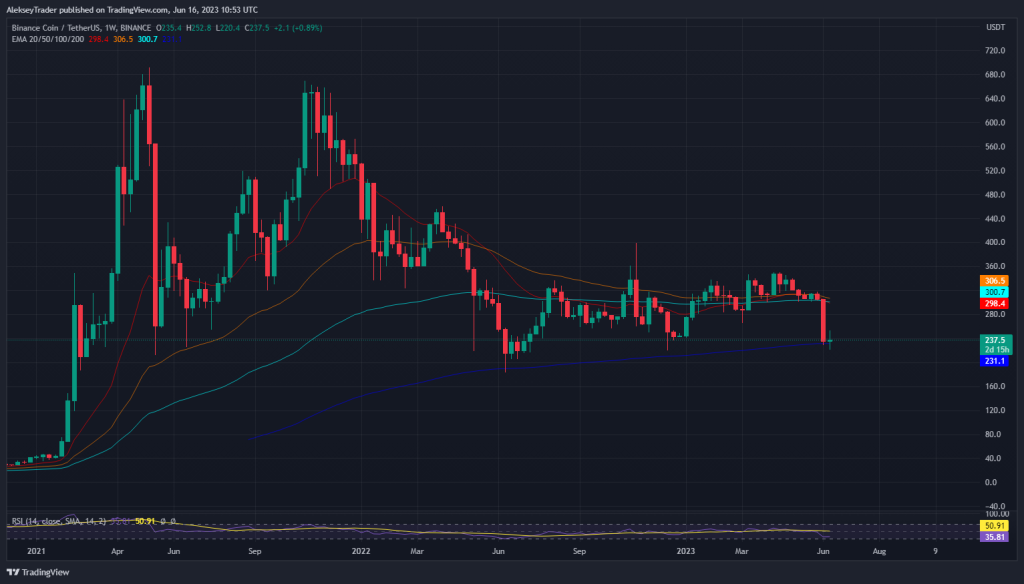
The Binance token (BNB), which serves as the native currency of the largest cryptocurrency exchange, experienced a 25% decline in value from June 5th to June 12th. This occurred after the U.S. Securities and Exchange Commission (SEC) filed a lawsuit against Binance and its founder. One of the main accusations is that the BNB token is not registered as a security, which exposes it to regulatory scrutiny. According to CoinGecko, BNB ranks fourth in market capitalization with a total value of $37.3 billion.
Following the collapse of the FTX token, which led to a rapid decline in the FTX exchange, market participants have become more cautious towards native tokens of crypto exchanges. Currently, the price of BNB stands at around $240, showing a recovery of approximately 9%. It is likely that the exchange’s statements regarding each of the negative events contributed to the price rebound.
Unofficial theories circulating on social media suggest that Binance, the largest cryptocurrency exchange, is selling its Bitcoin and stablecoin reserves to raise funds, which are then used to support the price of the BNB token after its sharp decline. However, Binance’s founder, Zhao, openly denies these rumors and claims that the exchange has not engaged in such actions, emphasizing that information about their reserves is publicly available.
In the SEC lawsuit, Binance and Zhao are also accused of misusing client funds, deceiving investors and regulators, and violating securities trading rules. Binance describes these accusations as “disappointing” and states that it intends to “vigorously defend” its platform.
Following the SEC’s lawsuit announcement, users started withdrawing their funds from the Binance exchange, resulting in a withdrawal of more than $700 million from the platform. Binance asserts that user assets on the exchange are “fully backed” and that they can easily process asset withdrawal requests of any size. Currently, the outflow of funds from Binance has decreased, and at the beginning of the week, there was a net inflow of funds totaling $455 million.
The TrueUSD (TUSD) stablecoin, which was relatively unknown before, has become the most actively traded asset on exchanges paired with Bitcoin, thanks to active support from Binance. In recent years, the majority of trading volumes on Binance consisted of trading pairs with USDT and BUSD, which benefited from a zero-fee program. However, in late March, trading fees for Bitcoin were reinstated, except for the BTC/TUSD pair.
This led to increased demand for this trading pair, and its share of trading volume on Binance grew to 50% within a month, starting from almost zero. On June 10th, due to issues with the Prime Trust issuer, the TUSD exchange rate slightly deviated from the dollar, but it was restored within a few days. As a result, the market capitalization of TUSD rapidly increased, growing by one and a half times from $2 billion to $3 billion overnight. This may be attributed to a simultaneous massive capital outflow from USDT to other stablecoins.
The market share of the TUSD stablecoin (TrueUSD) is still relatively small compared to the leading stablecoins USDT (Tether) and USDC (Circle). Previously, the BUSD stablecoin (Binance USD), issued by Paxos and supported by Binance, was also among the top three, but on June 16th, its market capitalization was surpassed by the DAI stablecoin for the first time. The BUSD market capitalization has decreased by over 70% since the beginning of the year.
BUSD was launched in 2019 as part of Binance’s Project Venus, positioning itself as the official stablecoin of the exchange. Initially, its market capitalization was low, but by the end of 2020, it experienced a sharp increase. Binance offered various promotions and bonuses for customers using BUSD, which contributed to its popularity and market capitalization growth. In 2022, the market capitalization of BUSD exceeded $23 billion.
However, by the start of the year, BUSD’s market capitalization had declined by 30%, as it was affected by the overall cryptocurrency market downturn and the bankruptcy of the FTX exchange. In February, Paxos, which provided the infrastructure for BUSD, received a subpoena from the SEC and ceased issuing the stablecoin for Binance. The BUSD market capitalization decreased to less than $12 billion.
When the SEC filed a lawsuit against Binance, the agency considered BUSD as an unregistered security, similar to Binance’s native token, BNB. As a result, the market value of BUSD started to decline rapidly. Currently, its market capitalization stands at $4.5 billion, representing an 80% decrease from its peak values.





